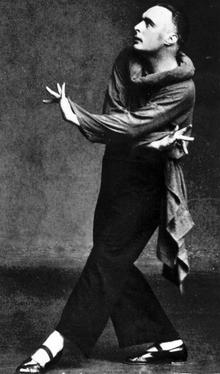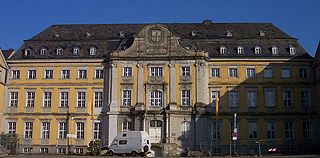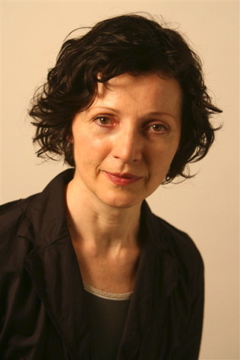
Rudolf (von) Laban, also known as Rudolph von Laban, was an Austro-Hungarian dance artist, choreographer, and movement theorist. He is considered a "founding father of expressionist dance" and a pioneer of modern dance. His theoretical innovations included Laban movement analysis and Labanotation, which paved the way for further developments in dance notation and movement analysis. He initiated one of the main approaches to dance therapy. His work on theatrical movement has also been influential. He attempted to apply his ideas to several other fields, including architecture, education, industry, and management.

Labanotation is a system for analyzing and recording human movement, invented by Austro-Hungarian choreographer and dancer Rudolf von Laban, who developed his notation on movements in the 1920s.

Dance notation is the symbolic representation of human dance movement and form, using methods such as graphic symbols and figures, path mapping, numerical systems, and letter and word notations. Several dance notation systems have been invented, many of which are designed to document specific types of dance while others have been developed with capturing the broader spectrum of human movement potential. A dance score is a recorded dance notation that describes a particular dance.

Kurt Jooss was a famous German ballet dancer and choreographer mixing classical ballet with theatre; he is also widely regarded as the founder of Tanztheater. Jooss is noted for establishing several dance companies, including most notably, the Folkwang Tanztheater, in Essen.

Yvonne Georgi was a German dancer, choreographer and ballet mistress. She was known for her comedic talents and her extraordinary jumping ability. In her roles as a dancer, choreographer, and ballet mistress, she was an influential figure in dance for decades.

Expressive dance from German Ausdruckstanz, is a form of artistic dance in which the individual and artistic presentation of feelings is an essential part. It emerged as a counter-movement to classical ballet at the beginning of the 20th century in Europe. Traditional ballet was perceived as austere, mechanical and tightly held in fixed and conventional forms. Other designations are modern dance and free dance, expressionist dance or new artistic dance, in Anglo-American countries German dance. In 2014, modern dance with the stylistic forms and mediation forms of rhythmic and expressive dance movements was included in the German List of intangible Cultural Heritage as defined by the UNESCO Convention for the Safeguarding of Intangible Cultural Heritage. German Expressionist dance is related to Tanztheater.

Mary Wigman was a German dancer and choreographer, notable as the pioneer of expressionist dance, dance therapy, and movement training without pointe shoes. She is considered one of the most important figures in the history of modern dance. She became one of the most iconic figures of Weimar German culture and her work was hailed for bringing the deepest of existential experiences to the stage.
The German Tanztheater grew out of German Expressionist dance in Weimar Germany and 1920s Vienna, and experienced a resurgence in the 1970s.
Yat Malmgren was a Swedish dancer and acting teacher, born in Gävle, Sweden to Gustaf Sigurd Eriksson and Signe Emma Maria Malmgren.
The Green Table is a ballet by the German choreographer Kurt Jooss. His most popular work, it depicts the futility of peace negotiations of the 1930s. It was the first work to be fully notated using kinetography Laban (Labanotation). It is in the repertoire of ballet companies worldwide, where it has been staged by Jooss himself. When he died in 1979, his daughter Anna Markard took over stagings of the work. With her death in 2010, Former Dutch National Ballet principal Jeanette Vondersaar assumed those responsibilities.

The Folkwang University of the Arts is a university for music, theater, dance, design, and academic studies, located in four German cities of North Rhine-Westphalia. Since 1927, its traditional main location has been in the former Werden Abbey in Essen in the Ruhr area, with additional facilities in Duisburg, Bochum, and Dortmund, and, since 2010, at the Zeche Zollverein, a World Heritage Site also in Essen. The Folkwang University is home to the international dance company Folkwang Tanz Studio (FTS). Founded as Folkwangschule, its name was Folkwang Hochschule from 1963 until 2009.

Susanne Linke is an internationally renowned German dancer and choreographer who is one of the major innovators of German Tanztheater, along with Pina Bausch and Reinhild Hoffmann.

Modern dance is a broad genre of western concert or theatrical dance which includes dance styles such as ballet, folk, ethnic, religious, and social dancing; and primarily arose out of Europe and the United States in the late 19th and early 20th centuries. It was considered to have been developed as a rejection of, or rebellion against, classical ballet, and also a way to express social concerns like socioeconomic and cultural factors.
Valerie Preston-Dunlop has an MA in movement studies and her PhD in choreography. She is a consultant and Honorary Fellow at London's Trinity Laban Conservatoire of Music and Dance. She conducted extensive research in the life and work of Rudolf Laban. She has written many books and directed DVDs that have contributed to the field of dance. She is a teacher, researcher, and dance scholar.
Frederic Alexander "Fritz" Cohen was a German composer best known for writing the music for Kurt Jooss's ballets.

Andrea Amort is an Austrian dance critic, dance historian, playwright, festival and exhibition curator as well as a non-fiction writer.
Wolfgang Martin Schede was a German writer, dancer, actor, choreographer, artist and photographer. He was credited with being for men's expressionist dance what Mary Wigman was for women's dance. After the experiment of running an expressionist theatre in Cologne, he founded a dance school there in 1923, and worked at the Theater Dessau from 1925. After World War II, he turned to writing, art and photography.

Frank-Manuel Peter is a German dance researcher and historian.
Kurt Peters was a German dancer, dance educator, dance critic, dance historian and publisher. In 1948, he founded the Deutsches Tanzarchiv Köln.
Fritz Böhme was a German dance publicist and cultural journalist.













